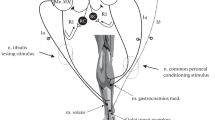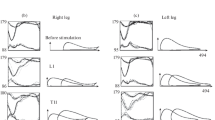The effects of activation of spinal locomotor centers at the cervical and lumbar levels on interlimb synergies were studied in humans. Subjects were placed on a biomechanical trainer in the supine position and carried out voluntary rhythmic leg movements, moving the carriage of the walking device of the trainer, or performing voluntary arm movements moving the levers of the trainer, or making simultaneous leg and arm movements. In the resting state, sequential transcutaneous stimulation of the spinal cord at three levels (cathode positioned between vertebrae C4/C5, T12/L1, or L1/L2) did not induce leg movements in most subjects, though performance of arm movements in combination with stimulation initiated low-amplitude (less than 10°) movements in all the leg joints. Stimulation of the spinal cord and simultaneous arm movements induced facilitation of the performance of voluntary leg movements, which was apparent as an increase in the integral characteristic of muscle electrical activity and an increase in movement amplitude at the hip joint. The results obtained here may be useful for developing a neurorehabilitation method for patients with impaired motor function.
Similar content being viewed by others
References
T. Wannier, C. Bastiaanse, G. Colombo, and V. Dietz, “Arm to leg coordination in human during walking, creeping and swimming activities,” Exp. Brain Res., 141, No. 3, 375–379 (2001)
P.-C. Kao, and D. P. Ferris, “The effect of movement frequency on interlimb coupling during recumbent stepping,” Motor Control, 9, No. 2, 144–163 (2005).
I. A. Colopova, V. A. Selionov, D. S. Zhvanskii, and A. A. I. A. Grishin, “Interaction of the upper and lower limbs in cyclic movements,” Fiziol. Cheloveka, 37, No. 4, 55–64 (2011).
Y. Gerasimenko, R. Gorodnichev, E. Machueva, et al., “Novel and direct access to the human locomotor spinal circuitry,” J. Neurosci., 30, No. 10, 3700–3708 (2010).
Y. Gerasimenko, R. Gorodnichev, A. T. Puhov, et al., “Initiation and modulation of locomotor circuitry output with multisite transcutaneous electrical stimulation of the spinal cord in noninjured humans,” J. Neurophysiol, 113, No. 3, 834–842 (2015).
E. S. Tomilovskaya, T. A. Shigueva, and A. Z. Zakirova, “Mechanical stimulation of the support zones of soles: The method of noninvasive activation of the stepping movement generators in humans,” Human Physiol., 39, No. 5, 480–485 (2013).
V. A. Selionov, I. A. Solopova, and D. S. Zhvansky, “Activation of interlimb interactions increases the motor output in legs of healthy subjects: study under the conditions of arm and leg unloading,” Human Physiol., 42, No. 1, 43–53 (2016).
Y. P. Gerasimenko, P. Gad, D. G. Sayenko, et al., “Integration of sensory, spinal, and volitional descending inputs in regulation of human locomotion,” J. Neurophysiol., 116, No. 1, 98–105 (2016).
A. A. Grishin, T. R. Moshonkina, E. V. Bobrova, and Yu. P. Gerasimenko, “A system for the rehabilitation therapy of patients with motor pathologies using mechanotherapy, transcutaneous electrical stimulation of the spinal cord, and biological feedback,” Med. Tekhnika, No. 4 (2019).
R. M. Gorodnichev, E. A. Pivovarova, and A. Puhov, “Transcutaneous electrical stimulation of the spinal cord: A noninvasive tool for the activation of stepping pattern generators in humans,” Human Physiol., 38, No. 2, 158–167 (2012).
N. Kawashima, D. Nozaki, M. O. Abe, and K. Nakazawa, “Shaping appropriate locomotive motor output through interlimb neural pathway spinal cord in humans,” J. Neurophysiol., 99, No. 6, 2946–2955 (2009).
H. J. Huang and D. P. Ferris, “Neural coupling between upper and lower limbs during recumbent stepping,” J. Appl. Physiol., 97, No. 4, 1299–1308 (2004).
D. Khusnutdinova, A. Netreba, and I. Kozlovskaya, “Mechanic stimulation of the soles support zones as a countermeasure of the conditions,” J. Gravit. Physiol., 11, No. 2, 141–142 (2004).
S. H. Collins, P. G. Adamczyk, and A. D. Kuo, “Dynamic arm swinging in human walking,” Proc. Biol. Sci., 276, No. 1673, 3679–3688 (2009).
D. De Kam, H. Rijken, and T. Manintveld, “Arm movements can increase leg muscle activity during submaximal recumbent stepping in neurologically intact individuals,” J. Appl. Physiol., 115, No. 1, 34–42 (2013).
I. A. Solopova, V. A. Selionov, O. V. Kazennikov, and Y. P. Ivanenko, “Effects of transcranial magnetic stimulation during voluntary and non-voluntary stepping movements in humans,” Neurosci. Lett., 5, 579–564 (2014).
J. E. Balter and E. P. Zehr, “Neural coupling between the arms and legs during rhythmic locomotor-like cycling movement,” J. Neurophysiol., 97, No. 2, 1809–1818 (2007).
E. P. Zehr, J. E. Balter, D. P. Ferris, et al., “Neural regulation of rhythmic arm and leg movement is conserved across human locomotor tasks,” J. Physiol., 582, No. 1, 209–227 (2007).
A. Frigon, “The neural control of interlimb coordination during mammalian locomotion,” J. Neurophysiol., 117, No. 6, 2224–2241 (2017).
E. P. Zehr, M. “Klimstra, and K. Dragert, et al., “Enhancement of arms and legs locomotor coupling with augmented cutaneous feedback from the hand,” J. Neurophysiol., 98, No. 3, 1810–1814 (2007).
I. Kozlovskaya, Afferent Control of Voluntary Movements, Nauka, Moscow (1976).
E. P. Zehr and J. Duysens, “Regulation of arm and leg movement during human locomotion,” Neuroscientist, 10, No. 4, 347–361 (2004).
Author information
Authors and Affiliations
Corresponding author
Additional information
Translated from Rossiiskii Fiziologicheskii Zhurnal imeni I. M. Sechenova, Vol. 105, No. 12, pp. 1581–1592, December, 2019.
Rights and permissions
About this article
Cite this article
Scherbakova, N.A., Bogacheva, I.N., Grishin, A.A. et al. Studies of Interactions between Limbs in Humans Subjected to Noninvasive Electrical Stimulation of the Spinal Cord. Neurosci Behav Physi 50, 1072–1078 (2020). https://doi.org/10.1007/s11055-020-01007-9
Received:
Revised:
Accepted:
Published:
Issue Date:
DOI: https://doi.org/10.1007/s11055-020-01007-9




